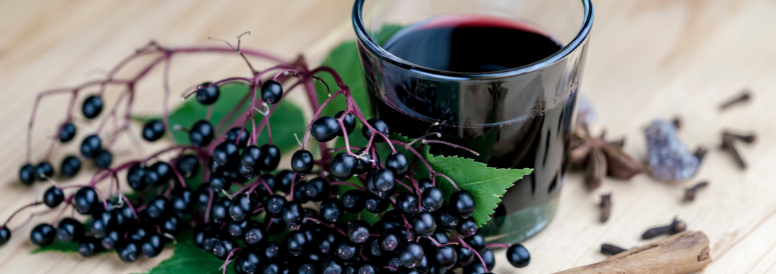Elderberry: A Foundation for Immune Health
(genus Sambucus) is a genus of about 10 species of deciduous shrubs or small trees with many trunks, that are native to forested temperate and subtropical areas around the world. It’s easy to identify by its large umbel of white flowers which produce a large cluster of dark red or purple-black shiny berries. The European Elder (Sambucus nigra L.) is a deciduous shrub that grows between twenty and thirty feet tall and can be pruned and trained into a tree form. It prefers a cool climate and is common in hedgerows in Ireland and England, and is cultivated for commercial use throughout Europe. The American Elderberry (Sambucus nigra L. ssp. canadensis), also a deciduous shrub, grows throughout the US and Canada. It rarely exceeds 13 feet in height and is more shrub-like.
Elderberries are very tasty, but the raw, uncooked berries (actually the seeds inside) are somewhat toxic and can make people sick if consumed in large amounts. They contain a cyanide-inducing glycoside. Eating a sufficient quantity of these glycosides can cause a toxic buildup of cyanide in the body producing symptoms of nausea, vomiting and diarrhea. Fortunately, most people recover quickly.
Ancient peoples soon realized that when cooked, the berries were not only safe to consume, but offered health benefits as well. Current research indicates that heating the elderberry actually concentrates the polyphenols and anthocyanins…which enhances elderberry’s health benefits.
When our ancestors discovered a medicinal plant, they usually investigated the healing properties of all parts of the plant, flowers, leaves, roots and bark in addition to the fruits. They soon discovered that the flowers are edible, but other parts of the Elder shrub or tree are more toxic than the berries and should not be consumed unless cooked. The long history of use in traditional folk medicine has shown that when properly prepared, elderflower and elderberry syrups and extracts are safe and effective allies. As documented in the writings of Hippocrates, Dioscorides, and Pliny the Elder, elderberries and elderflowers have long been used for making preserves, syrups, wines and winter cordials to support health.*
Modern science has validated elderberry’s immune support properties.* The high biological activity of its phenolic compounds including quercetin, rutin, kaempferol and anthocyanins are still being studied to understand the mechanisms of action. But there are a few things that science has uncovered.
Scientists have been most fascinated by elderberries rich deep color from anthocyanins. Elderberry anthocyanins incorporate into both cell membranes and cytosol and exert potent antioxidant effects. They counteract oxidative stress, increase the activity of antioxidant enzymes in blood and additionally, increase production. All these processes are necessary for optimal immune system function. Reducing oxidative DNA damage is another benefit of this high antioxidant activity.*
Elderberries also specifically support the immune complement system.* The complement system is a part of the immune system that enhances (complements) the ability of antibodies and phagocytic cells to clear microbes and damaged cells from an organism, promote healthy inflammation, and attack the pathogen’s cell membrane. It is part of the innate immune system, which is not adaptable and does not change during an individual’s lifetime. The complement system can, however, be recruited and brought into action by antibodies generated by the adaptive immune system. Studies have shown that activate immune complement, having complement fixating activity.*
Recently, in February of 2019, a meta-analysis of randomized controlled clinical trials investigating the action of black elderberry in 180 participants with upper respiratory symptoms, was published in Complementary Therapies in Medicine, vol 42, and concluded that elderberry substantially supported immune status.*

